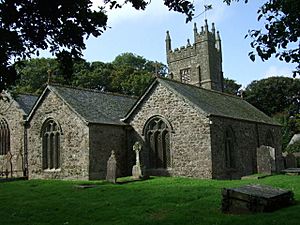St Gwinear's Church, Gwinear facts for kids
Quick facts for kids St Gwinear’s Church, Gwinear |
|
|---|---|

St Gwinear’s Church, Gwinear
|
|
| 50°11′15.05″N 5°22′11.83″W / 50.1875139°N 5.3699528°W | |
| Location | Gwinear, Cornwall |
| Country | England |
| Denomination | Church of England |
| History | |
| Dedication | Saint Gwinear |
| Administration | |
| Parish | Gwinear |
| Deanery | Penwith |
| Archdeaconry | Cornwall |
| Diocese | Diocese of Truro |
| Province | Province of Canterbury |
St Gwinear's Church, Gwinear is a very old and important church located in Gwinear, Cornwall, England. It is a special building because it is a Grade I listed church. This means it is considered a building of great historical and architectural importance. The church is part of the Church of England.
Contents
History of St Gwinear's Church
Early Beginnings
St Gwinear's Church is named after Saint Winierus. Legend says he was a leader of Irish missionaries. They came to this area in the 6th century. There was once a holy well and chapel dedicated to him at Roseworthy. This site also had a beautiful Celtic cross.
The right to appoint the church's priest, called the advowson, once belonged to the Drannack manor. In 1311, it was given to Sir Richard de Stapeldon. He held it for a college in Oxford, which later became Exeter College.
Building and Changes
The main parts of St Gwinear's Church were built in the 13th and 14th centuries. The tall tower was added in the mid-15th century. It is made from strong granite stone and has three main sections.
The church has three aisles, which are long walkways. There is a south aisle, an inner north aisle, and another aisle further north called the Arundell Aisle.
Restoring the Church
Over the years, parts of the church have been repaired and updated. In 1870, the chancel, which is the area around the altar, was restored. The roof was fixed with oak wood and made taller. New stone decorations and a cross were added to the roof's peak. The large window with five sections was rebuilt to look like the original. New oak seats were also put in the chancel.
More restoration work happened between 1878 and 1879. The aisles and roofs were repaired. Four new roofs cost £689. A new window with three sections was placed at the west end of the south aisle. The screen that separates the chancel was fixed and put back in its original spot. New seats made of pitch pine wood were added. The floors were covered with concrete, and the aisles were laid with smooth slate stones from Delabole. The church was lit with special Hesperus lamps. The church was officially reopened on November 25, 1879. The new bells rang for the first time on January 23, 1880.
Sharing Parishes
St Gwinear's Church is part of a group of churches that work together. This is called a joint parish. The other churches in this group are:
- St Elwyn's Church, Hayle
- St Erth's Church, St Erth
- St Felicitas and St Piala's Church, Phillack
- St Gothian's Church, Gwithian
The Church Organ
The church has an organ that helps lead the music during services. The first organ was made by Hele & Co. It was played for the first time on January 14, 1925, by Hubert Stanley Middleton. He was the organist at Truro Cathedral.
This organ was later replaced in 1993. The new organ came from Tregajorran Wesleyan Chapel and was built in 1922 by Griffen and Stroud. You can find more details about this organ on the National Pipe Organ Register.

